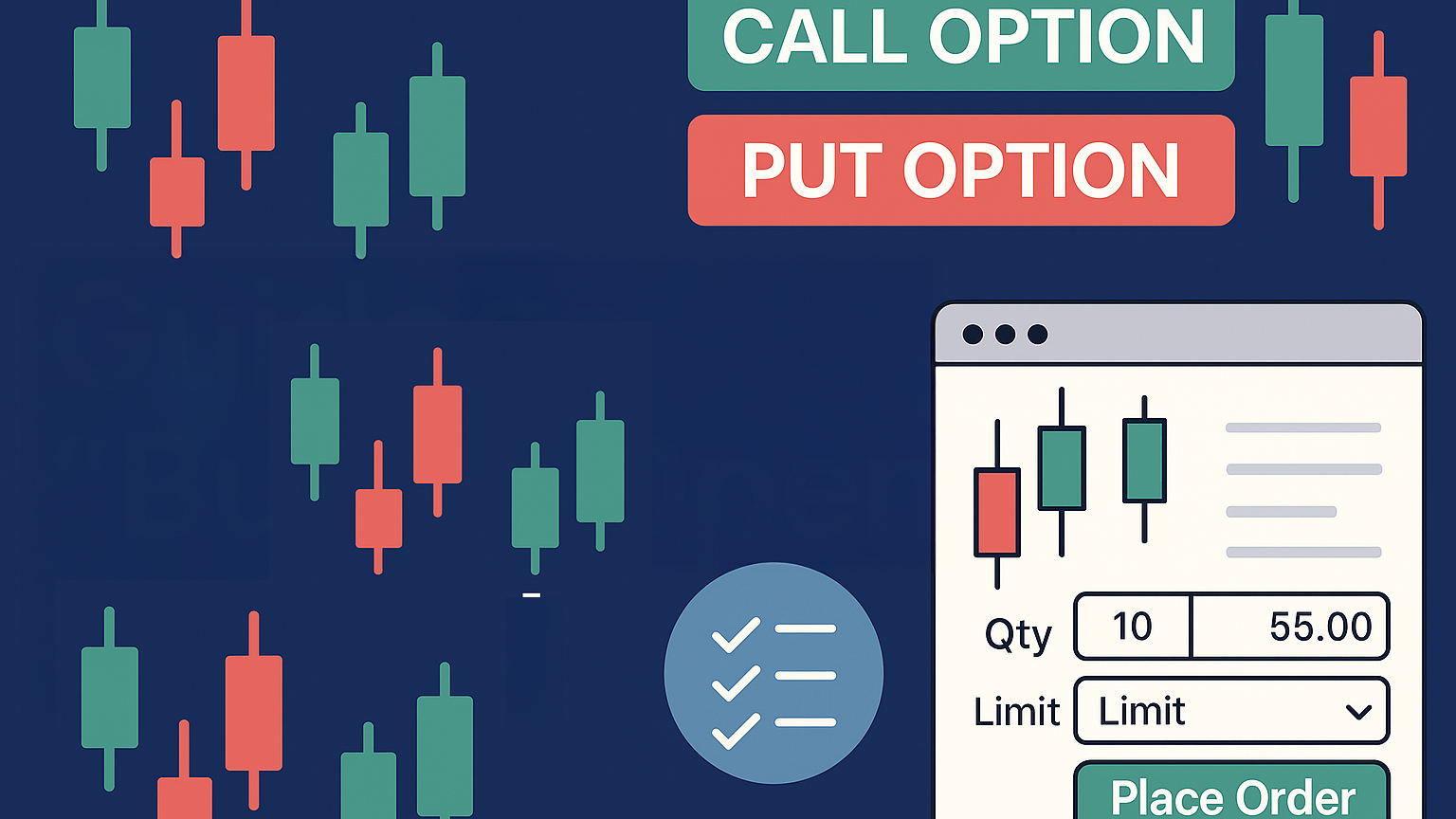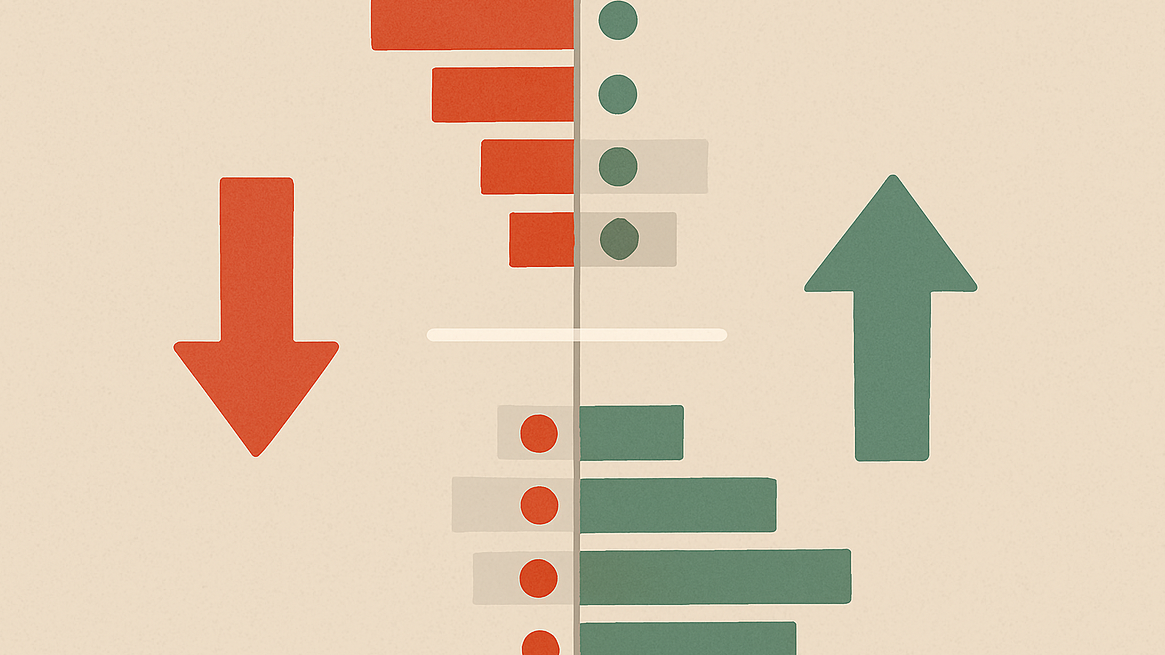Learn the essentials of 'buy to open' in options trading, including order types, strategies, and risk management techniques.
"Buy to open" is a simple way to start a new position in options trading. Whether you're buying calls to bet on rising prices or puts to profit from falling prices, this order type helps you take advantage of market movements while managing risk. Here's what you need to know:
- What it Means: Use "buy to open" to purchase options and open a long position.
- How it Works: Choose the option type (call or put), strike price, expiration date, and number of contracts.
- Key Benefits: Limit your risk to the premium paid, hedge your portfolio, or speculate on market trends.
- Exit Strategies: Use limit orders, trailing stops, or stop-loss orders to manage profits and losses.
Quick Comparison of Order Types:
| Order Type | Purpose | Position Effect |
|---|---|---|
| Buy to Open | Start a new long position | Opens a new position |
| Buy to Close | Close an existing short position | Closes an existing position |
| Sell to Open | Start a new short position | Opens a new position |
| Sell to Close | Exit an existing long position | Closes an existing position |
Start by practicing with a paper trading account, analyze market trends, and always review your trade details before placing an order. This approach ensures you're prepared to trade options effectively and confidently.
Placing 'Buy to Open' Orders
Order Entry Steps
To place a buy to open order, start by accessing your options chain and setting the necessary parameters. Choose the asset and the option type (call or put) based on your market outlook. Then, define details like strike price, expiration date, and the number of contracts you want to trade.
The trading interface typically shows important details such as:
- Contract specifications
- Current bid/ask prices
- Order types (market, limit, stop)
- Order duration options (e.g., day or GTC)
Once you've set everything, double-check your trade parameters before submitting the order.
Pre-Order Checklist
Before finalizing your buy to open order, make sure to review these critical points:
| Check Point | Key Considerations |
|---|---|
| Market Analysis | Look at trends, support, and resistance levels |
| Risk | Assess position size and potential loss |
| Technical Factors | Check volatility and upcoming events |
| Order Details | Confirm strike price, expiration, and quantity |
| Account Status | Ensure you have enough buying power and meet margin requirements |
These checks align with the risk and market analysis principles we've covered earlier.
Sample Trade Walkthrough
Here’s a quick example to guide you through placing a buy to open order:
- Initial Setup: Log into your brokerage account and open the options chain for your chosen asset.
- Order Configuration and Execution: Enter your order details - such as limit order type, day order duration, number of contracts, strike price, and expiration date. Once everything looks good, click "Place Order." Keep an eye on your order status in the Trading Panel.
Trading Methods Using 'Buy to Open'
Call Options and Upward Moves
Call options bought with 'Buy to Open' orders can be a way to benefit from rising stock prices. Your maximum risk is the premium you pay, while the profit potential can be substantial.
For instance, imagine a stock trading at $50, and you anticipate it climbing to $60. You could place a buy to open order for a call option with a $55 strike price.
Here’s a quick look at popular call option strategies:
| Strategy | Initial Cost | Maximum Risk | Profit Potential | Best Used When |
|---|---|---|---|---|
| Single Call | Premium paid | Limited to premium | Unlimited | Strong bullish view |
| Bull Call Spread | Reduced premium | Limited to net premium | Capped by spread width | Moderately bullish |
A bull call spread, where you buy one call and sell another at a higher strike price, can reduce the upfront cost. However, this approach limits your profit potential because of the capped spread.
On the other hand, put options can be a go-to strategy when you expect prices to drop.
Put Options and Downward Moves
Put options allow you to benefit from falling stock prices or safeguard your portfolio.
For example, if XYZ stock is at $50, you could buy a put option with a $50 strike price for a $5 premium (or $500 per contract).
Here’s how put options stack up against short selling:
| Feature | Put Options | Short Selling |
|---|---|---|
| Maximum Loss | Limited to premium paid | Theoretically unlimited |
| Profit Potential | High if stock drops significantly | Limited to stock reaching zero |
| Initial Capital Required | Option premium only | Margin requirements |
| Time Sensitivity | Expires if out of the money | No expiration date |
Put options can also serve as a hedge for your portfolio. However, in volatile markets, premiums tend to increase, so timing becomes critical. To make the most of this strategy, carefully align strike prices and expiration dates with your market expectations and risk tolerance.
Understanding Buy to Open and Options Order Types
Monitoring and Closing Positions
Once you've initiated your "buy to open" trades, keeping an eye on them and having a solid plan for exiting is crucial for managing risk and maximizing potential returns.
Position Management
Keeping track of your positions is key in options trading. Most trading platforms offer real-time data, such as profit and loss (P&L), margin requirements, and liquidity metrics. To stay organized, group your trades based on:
- Instrument Type – Separate options from other asset classes.
- Industry/Sector – Understand your exposure to specific markets.
- Long/Short Status – Quickly gauge your directional bias.
- Expiration Date – Monitor time decay and prioritize accordingly.
Many platforms include features like "Options Ticks", which provide live market data, including prices, trading volumes, and institutional activity. With this information at hand, you can make informed decisions and set effective exit strategies.
Exit Strategies
Having a clear exit plan before entering a trade is essential. Here are some common approaches:
- Use limit orders to lock in profits at a specific target price.
- Set trailing stops to secure gains as the market moves in your favor.
- Employ OCO (One Cancels the Other) orders to manage both profit and loss exits simultaneously.
- Define a maximum acceptable loss (e.g., 50%) and set stop-loss orders to exit if that threshold is reached.
For instance, if you buy an XYZ January 80 call at $3, you might set a limit sell order at $6 to take profits and a stop-loss order at $1.50 to minimize losses.
When it's time to close a position, keep a close watch on the underlying asset's price. If the price moves in your favor, consider locking in profits before the option expires. On the flip side, if the price moves against you, closing the position early can help limit potential losses.
Top Mistakes to Avoid
Making errors with "buy to open" orders can derail your trading strategy. To safeguard your capital while managing and closing positions, steer clear of these common pitfalls.
Position Sizing
Keep your risk in check by limiting it to 1-2% of your total capital per trade. Align your contracts with your usual stock position size - one contract for every 100 shares. For instance, if your standard trade involves 300 shares, aim for three contracts.
Price Impact Factors
Option prices are heavily influenced by market conditions. Here's a quick breakdown:
| Factor | Impact | Risk Management Strategy |
|---|---|---|
| Implied Volatility | Drives prices higher | Compare to historical averages |
| Time Decay | Accelerates near expiration | Opt for longer-dated options |
| Liquidity | Affects trade execution | Look for open interest 40x higher |
Highly liquid options like QQQ and SPY often have tight spreads, sometimes as narrow as $0.01. On the other hand, less liquid options come with wider spreads, making exits more difficult.
Analysis Tools
Effective analysis goes beyond just understanding pricing. Use these tools to strengthen your trading decisions:
- Track real-time market data and option chain stats.
- Stay aware of upcoming events that could impact your trades.
- Use limit orders to maintain better control over entry and exit prices.
"Failing to understand liquidity is one of the biggest risks for new traders." - Mike Martin, Vice President of Market Strategy at TradingBlock
Finally, if you're holding onto 80% or more of your gains from selling an option, think about buying it back to lock in profits.
Conclusion: Getting Started
Key Takeaways
Every trade should align with the current market environment. To master "buy to open" orders, start by understanding the basics of options trading. This order type limits your risk to the premium you pay. Calls can provide unlimited potential gains, while puts help protect against market downturns.
Your success depends largely on timing and market conditions. Here are some important factors to keep in mind:
| Component | Key Focus | How to Approach It |
|---|---|---|
| Market Analysis | Use technical indicators | Tools like moving averages and RSI are helpful |
| Position Entry | Choose the right order type | Limit orders are generally safer than market orders |
| Risk Management | Manage position size | Begin with smaller trades to limit exposure |
| Market Conditions | Assess volatility | Regularly monitor market fluctuations |
Practical Next Steps
Start applying these ideas with a hands-on approach:
- Open a paper trading account to practice without risk.
- Set your paper trading balance to match the amount you plan to invest.
- Practice placing "buy to open" orders for both calls and puts.
- Keep a log of your trades, noting the reasoning behind each one and the results.
"The key is to try to paper trade like you would if you were trading real money." - Optimus Futures
Once you feel confident, transition to real trading with small, calculated positions. Always do thorough research and stay aware of market updates, including economic news and global events that might affect your trades.
"You can use options to speculate and to gamble, but the reality is ... the best use of options is to protect your downside." - Randy Frederick, managing director of trading and derivatives with the Schwab Center for Financial Research






